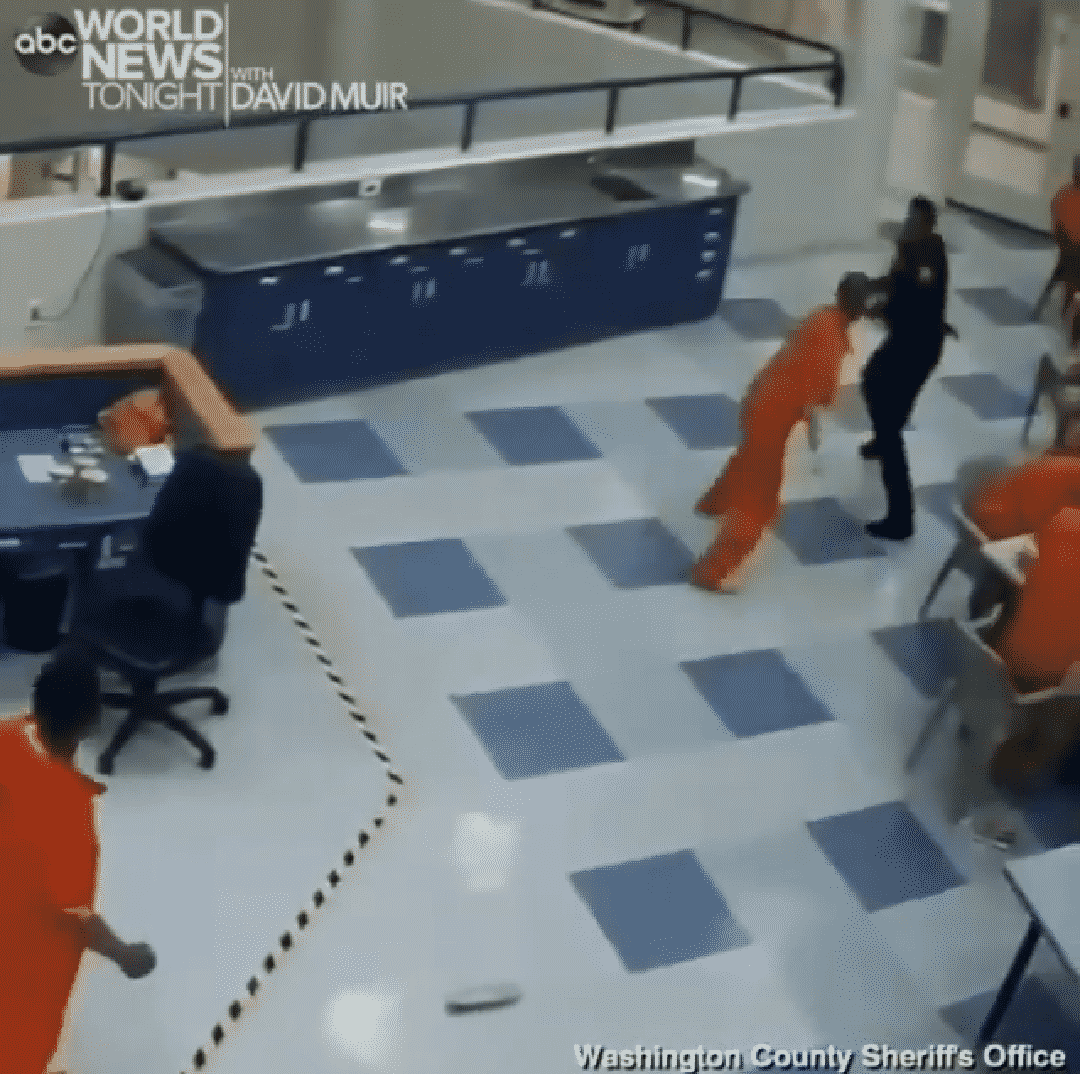Deputy Guzman in his own words,
On March 31, 2019, I arrived to work and grabbed all my paperwork for my overtime post in Pod 4. Before I go any further, let me just touch base on Pod 4 first. Pod 4 is what we call the Special Needs Pod, a.k.a. SNP. The people housed in this area are people who would not do well in a General Population unit. Aside for being on medications for mental health, (i.e. bipolar, schizophrenia, etc.) these people also have a higher potential of being taken advantage of by other inmates. So much like the maximum security units are used to keep people who don’t play well with others, separate. We use this pod to protect these individuals of that risk. So now that that’s out of the way let me continue with my day.
I did a head-count in the unit and appeared to be accurate with my paperwork. “As soon as count clears, we can start some out-time and then later close up shop and start my regular graveyard shift.”
At approximately 1930 Hours, the head-count in the facility was cleared and it was time to begin out-time. Prior to opening all the doors, I give my usual announcement over the intercom, briefly explaining my expectations and rules. A minute later, the doors are opened using the computer at my desk.
Inmates speed walk to the tablets, some to get front row to the TV area, some for access to the showers and others begin to make a line in front of the deputy station. All familiar to me as it’s seen almost on a daily. What was NOT familiar was THAT guy. As everyone is doing what appears to be the norm to me, he walked in front of my desk with his hands behind his back. Without breaking eye contact he stared at me until he was past my desk and continued on. It’s not uncommon in here to see people off in their own world. Mental health issues are a reality people often mistake for something else.
I quickly shook that off and continued on with the people in front of my desk. One of the first rules I learned (if not all, then most people in a correctional setting) is “keep your head on a swivel.” Second, “Never sit down when you have inmates out.” Well… I eventually broke that one.
I finished helping the last person near my desk and took a look around the pod. Some were playing chess while others shuffling cards. People were sitting near the TV area watching a movie, and others doing laps outside in the rec area. But THIS guy. This guy walked in front of my desk again and would not break eye contact. So I greeted him. “What’s up man? How’s it goin’?” And he replied with… nothing. He continued to stare until he walked past my desk and continued on. Something was not right.
As I watched him slowly walk away from the desk to start another lap inside the day room, someone approached and asked if I could look up their next court date. So as I log in, I pull out the chair from the desk and sit down. This process only takes, if anything, 10 seconds to do. So the court date was given and that person left. As I turn around to stand up, I had another inmate approach me from the outside rec area and ask if I could do the same for him. I had the inmate come around the desk and the results were given. Here, at this moment, is where things began to go a different direction.
The inmate asked me a question about his charges. And after that question was answered, he asked another. And then another…. and then another. In the process of answering these questions, I noticed someone in orange standing off to my left. At a distance, not yet close enough to the yellow and black line around my desk. I did not address it or pay TOO much attention to it because I was under the impression that it was just another inmate wanting to have access to his room. To put his shower shoes away or lock up their ramen noodles so no one steals it. Either way, through my peripheral vision, I knew someone was there.
I continued answering these questions and realized TWO things. First thing, I haven’t seen ol’ boy in a minute. So I do a quick glance in front of my desk, towards the TV area and he was not in sight. So I looked up at a mirror that hangs on the pillar in front of my desk. I turn my head and realize that the person who I saw in my peripheral, was actually the guy who had been staring at me since the beginning of out-time. Second thing, I realized had been sitting down for longer than I had wanted.
I immediately stopped answering questions for the other inmate and addressed this guy. “Did you need something?” Silence was the response. “Do you have any questions?” This inmate looks down at his feet, and slightly rocking his body back and forth. He then looks at me again without saying a word. “I need you to keep walking. I don’t need you standing behind me. Come around the desk if you have any questions.”
Right after this is when he charged at me the first time. When he charged at me, I was still trying to figure out if he was rocking forward and was waiting on the “back” part. I then realized there would be no “back” at that point. I pushed off the desk and he landed in front of me. I pushed off him and stood up at the same time. I covered my head and tried to move away from my desk into an open area. He continued swinging and as I side stepped away, he tripped and fell to the ground. Here is the space I needed. I reach behind me and press my duress pager, signaling for backup to my location. I begin to move away from my desk into an area that’s open and away from keyboards and monitors. I move to this area knowing there are no inmates there or any that can sneak up behind me without me being aware. The inmate stands up and charges at me for a second time. I swing and he ends up on the ground. The perfect opportunity to go in and handcuff… and we can call it a day! But, no, I can’t… I have 55 inmates out and about. Going to the ground is not the smartest thing to do. I back away towards the entrance of the pod. That’s where my back up is coming through. Oh snap! He’s charging at me again!
As I continue to defend myself, I begin to bob and weave as best as I could while walking closer and closer to the entrance. I’m seeing more and more orange come closer to me. I have to end this or get out of this area. I reach for the inmates left arm and as I was about to pull him on the ground, I see another inmate start to swing, so I pushed. But I forgot to let off the arm I was holding on to and went to the ground anyway. I was now I top of two inmates and more than a handful of inmates were within arms’ reach.
My right knee is on top of one inmate, my left leg pushing off the ground putting constant pressure on both inmates. My right hand keeping the inmates hand away from my face. And my left hand reaching for the only tool I had available — my pepper spray. I began to yell at everyone to get back and cell in. I repeated it several times as people began to leave. Some were pulling on the inmate’s feet. My thoughts; Is he trying to pull him out? Prone him down and help? “GET BACK AND CELL IN!!”
I’m now clear from inmates, except this guy walking up… “Guzman, are you good? Do you need more help?”
I take a deep breath and reply “I’m good! You need to cell in right now!”
“Are you sure? I’m here if you need it…”
Again, I look at him and reply, “thank you but I need you to listen… my back up is coming through those doors any second. And you don’t want to be standing there when they come through. I need you to cell in.”
I now look down to see what I’m dealing with on the second inmate… oh… he has him in a choke hold. The second inmate looks at me and says, “I’m sorry deputy! I couldn’t just sit there and watch!”
I replied “You’re fine! Just. Don’t. Move!” I haven’t heard a single radio call since I hit my pager… where’s my back up?? Why have I not heard anything??? A brief moment later I realized my earpiece was not where it was supposed to be — in my ear. So I unplugged the earpiece and radioed for back up. “I need back up to pod 4… inmate fighting staff!” I hear the elevator doors. Someone is coming. *sigh* I look down and ask the guy why. His reply was, “You made me bleed my own blood!” Confused, I asked, “what did you think was going to happen?!” And he continued stating, “Because of you, I’ll never see my family again. Because of you, I’ll never see my kids. Because of you I’m in here!”
I thought to myself “I don’t even KNOW you!!” But then shook that off when I remembered what unit I was working. Today, for this moment, I was a part of his world. Back up arrived. The inmate that helped was moved away from the area. The other deputies and I rolled this inmate over and began to give instructions to give me his right arm. As I pulled his right arm out, I saw his hand was wrapped in medical gauze… and sticking out of in between his fingers was a wooden tongue depressor. Not sharpened but still, very present. I realized the only hit I took to the face, could have had a different outcome had my training been taken lightly or as a joke. Thankfully, this is never and won’t ever be the case with DTs (defensive tactics) or any other training I go through. I was then removed from the area by my Sergeant and was asked what had happened. About 40 minutes later, I found out that Davis was the last name of the guy who attacked me. I filed my report, dusted myself off and went on to continue my regular graveyard shift. I was told that if I wanted to go home and be with my family, I could. “I got one more day ‘til my weekend. I’m tired. But I don’t rest when I’m tired. I’ll rest when I’m done.” Sergeant nodded their head, told me I did a great job. And the rest of the night went on just like any other night.
A rare event occurred in our facility. Though dealing with “disruptives,” drunks, people that come in high or just plain pissed off, is a norm, attacks on staff in an open area like this in this facility is a rare thing. I come from a background of 8 years in loss prevention. This is my first law enforcement position ever. If I can give any advice to anyone new in the field, it’s these few things:
1. Keep your head on a swivel. Build that habit and it will always be second nature.
2. LISTEN when it is time to listen. Your training is crucial and important to everything you (your family in blue, or family in general) may encounter in your day-to-day life. Much like why policies are in place, someone, somewhere, went through a crappy situation and now became a training scenario. So take your training seriously.
3. Treat others the way you want to be treated. A core value that the Washington County Sheriff’s Office lives by. Respect that is EARNED goes further than respect that is TAKEN. Not everyone in jail is bad. Treat everyone fairly, and maybe one day one of them will help you out when you really need it.
And last but not least… don’t ever break your own rules. Complacency is NOT your friend. I broke my own rule because I felt comfortable. And it almost cost me my life — if not my life, then at minimum my vision. The only hit I took was to my face, but his knuckle and the tongue depressor scratched about an inch below my eye.
I have gotten support from all over the nation — my family, friends and my extended family in blue… the deepest and most humbled thank you to all of you. I will not stop when I am tired. I will stop when I am done.


